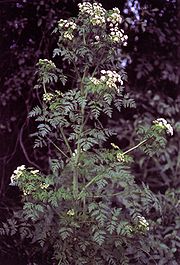Poisonous Weeds in Horse Hay
by Debora Johnson
Horses are generally pretty adept at avoiding poisonous weeds when they are grazing. However, when it comes to identifying poisonous weeds that are contained in the hay that is purchased to feed your horse, they are not so readily able to identify the poisonous weeds. Ingestion of too many toxic weeds can be deadly to your horse.
The three most common toxic weeds to horses that may be contained in hay are: Hoary alyssum, wild parsnip and poison hemlock.
- Hoary alyssum - Hoary alyssum is a perennial weed. After draughts this weed is often found in larger amounts in pastures and hay fields. It is a gray or light green with white flowers and contains small, oblong seeds. Some of the symptoms your horse may exhibit after ingesting this toxin are swelling of the limbs, stocking up, founder and death. The amount of hoary alyssum that a horse must eat to cause problems differs from horse to horse. Some have no tolerance at all. Hay containing greater than 30% hoary alyssum should not be fed to horses. (Hoary Alyssum in Hay, Pasture and Forage/University of Minnesota)
Hoary Alyssum (Berteroa incana)
- Wild parsnip - Wild parsnip is mainly found in ditches and fields and is a biennial and is poisonous to horses. "Description: Appearance: Monocarpic perennial herbaceous plant (plant spends one or more years in rosette stage, blooms under favorable conditions, and then dies), 6" high in the rosette stage and 4' high on stout, grooved stems in the flowering stage. Leaves: Alternate, leaf is made up of 5-15 egg shaped leaflets along both sides of a common stalk; leaflets sharply-toothed or lobed at the margins; upper leaves smaller. Flowers: Flat-topped broad flower cluster 2-6" wide, numerous five-petaled yellow flowers; bloom from June to late summer. Seeds: Small, flat, round, slightly ribbed, strawcolored, abundant take 3 weeks to ripen before they can reseed; viable in the soil for 4 years. Roots: Long, thick, edible taproot." It is not known how much a horse must ingest to exhibit the toxic effects.
Warning - Wild parsnip contains a toxin called furanocoumarins that can create severe skin irritations. Wear gloves, long sleeves and long pants to avoid any direct skin contact with this toxin. A rash, blistering and skin discoloration (phytophotodermatitis) may be symptoms that appear with contact.
Wild Parsnip (Pastinaca sativa)
- Poison hemlock - Poison hemlock is poisonous to horses. If a horse consumes 0.25% of its body weight it can be deadly. Symptoms are salivation, excitement and death. It is basically not treatable. Poison hemlock is happiest in wet places. It is a biennial. Hemlock is known by several common names: the American Poison hemlock and the Irish Devil's porridge, Beaver Poison, Herb Bennet (not to be confused with the geranium of that name), Musquash Root, Poison Parsley, Spotted Corobane and Spotted Hemlock. The seeds are sometimes called Kecksies or Kex. By far the most familiar species is Conium maculatum (Hemlock or Poison Hemlock). It is a herbaceous biennial plant which grows between 1.5-2.5 metres (5-8 ft) tall, with a smooth green stem, usually spotted or streaked with red or purple on the lower half of the stem. The leaves are finely divided and lacy, overall triangular in shape, up to 50 centimetres (20 in) long and 40 centimetres (16 in) broad. The flowers are small, white, clustered in umbels up to 10-15 centimetres (4-6") across. When crushed, the leaves and root emit a rank, unpleasant odour sometimes compared to that of parsnips or mice. Poison hemlock/Conium
 Poison Hemlock (Conium maculatum)
If you notice that your horse has any of the above symptoms call your vet immediately. Diagnostic tests can be done to determine what the problem may be. A timely response is important.
For More Information:
Weeds Toxic to Horses
Veternary Medicine Library
Harmful Horse Pasture Invaders
Weeds in Horse Pastures
Horse Extension 
|
